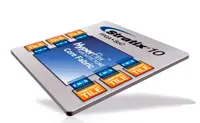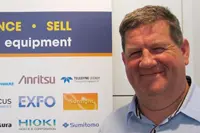Electronics News
Archive : 8 June 2015 год
 Cadence has announced the next generation of its JasperGold formal verification platform. The solution blends Cadence's Incisive formal technology with JasperGold into a platform that is said to deliver an improvement in performance of up to 15x compared with previous solutions.
Cadence has announced the next generation of its JasperGold formal verification platform. The solution blends Cadence's Incisive formal technology with JasperGold into a platform that is said to deliver an improvement in performance of up to 15x compared with previous solutions.
The company acquired Jasper about a year ago, but has decided to retain the Jasper branding. Pete Hardee, director of product management, formal and automated verification, said brand recognition was strong and claimed the Jasper architecture is 'very good, extensible and flexible'.
Design compilation and formal engine technologies from Incisive Formal Verifier and Incisive Enterprise Verifier have been included in the latest release, including the Trident multi-cooperating engines.
Hardee said there are many formal engines in the tool, all of which use different algorithms. "The traditional approach is to run them in parallel and see which engine wins. Trident allows engines to hand off properties from one to another, so the best engine is used at any stage.
JasperGold has also been integrated with the Incisive simulation and Palladium emulation platforms, while Visualize and QuietTrace technologies have been integrated with the Indago debug platform.
Author
Graham Pitcher
Source: www.newelectronics.co.uk
 Two years after announcing Stratix 10 SoC FPGAs, Altera has disclosed more details about how the devices – being built on Intel's 14nm TriGate process – achieve the claimed performance.
Two years after announcing Stratix 10 SoC FPGAs, Altera has disclosed more details about how the devices – being built on Intel's 14nm TriGate process – achieve the claimed performance.
Alongside quad Cortex-A53 processors, the parts also take advantage of Intel's Embedded Multi Interconnect Bridge (EMIB) and what's called the Hyperflex architecture.
Chris Balough, senior director of SoC product marketing, noted: "Stratix 10 is the flagship. This is the most significant step forward in high end FPGAs. The level of integration is amplified by Intel's process and packaging technology."
The move to Hyperflex was said by Balough to not have been made lightly. "We have been working on the architecture for about five years to make sure we're confident." He added the greatest benefits will be found in datapath applications. "They tend to be the ones you want to speed the most," he added.
Stratix 10 FPGAs will be able to attain GHz frequencies, according to Balough. "If you want GHz frequencies, you have two choices: either wider buses to move more things in parallel or you have to address routing delays."
In his view, wider buses is an inadequate solution, because it affects power consumption and die size. "So we have addressed the problem by adding registers."
HyperFlex sees registers distributed across all core interconnect routing segments. This is said to allow such design techniques such as register retiming and pipelining to be applied – techniques claimed as not practical in conventional FPGAs.
"HyperFlex is not just for extra throughput," Balough pointed out, "it's also for those who want smaller FPGAs that use less power."
In an example application, Altera pointed to a data centre application that previously required five Stratix V FPGAs and which consumed 120W. The application is said to run on one Stratix 10 SoC FPGA which consumes 44W.
Similarly, in a wireline optical switch application, one 900k LE Stratix V device drawing 47W can be replaced with a 650k LE Stratix 10 drawing 28W.
Meanwhile, EMIB technology enables 3D heterogeneous integration. While the FPGA die will be made on Intel's 14nm process, the 'tiles' which provide additional functionality will be made on a 20nm line. Altera will initially provide PCIe Gen 3 tiles running at up to 30Gbit/s, but plans a range of other comms tiles, including optical interfaces.
Balough said 'eight to 10' Stratix 10 parts will be available, with the largest device featuring 5.5million logic elements. First shipments of Stratix 10 devices are planned for Q4 2015.
Author
Graham Pitcher
Source: www.newelectronics.co.uk
 Synopsys is buying Atrenta in deal which is said to provide designers with a more comprehensive portfolio of silicon to software solutions for complex electronic systems.
Synopsys is buying Atrenta in deal which is said to provide designers with a more comprehensive portfolio of silicon to software solutions for complex electronic systems.
"Atrenta's demonstrated leadership in static and formal technologies is recognised throughout the EDA industry and its technology is used by design and verification teams around the world," said Manoj Gandhi, pictured, general manager of Synopsys' Verification Group.
Atrenta has a range of software which is targeted at SoC design and verification and Gandhi expects to integrate this functionality into its Verification Continuum and Galaxy Design platforms.
"Synopsys expects to leverage this strong technology to further improve our Verification Continuum platform to address continually increasing verification challenges, and to support our ongoing R&D collaborations with customers in both verification and implementation," Gandhi added.
Pic: Manoj Gandhi, general manager of Synopsys' Verification Group
Author
Graham Pitcher
Source: www.newelectronics.co.uk
 Electronic test equipment specialist Electro Rent is establishing a UK office. Although the company has been servicing the UK market for the last 10 years from its European headquarters, increasing levels of business mean the UK office will be able to better support customers.
Electronic test equipment specialist Electro Rent is establishing a UK office. Although the company has been servicing the UK market for the last 10 years from its European headquarters, increasing levels of business mean the UK office will be able to better support customers.
Electro Rent Europe's managing director David Saeys, pictured, said: "Establishing a local presence is a logical next step and will enable us to provide a true local service to existing and future customers."
According to Saeys, 75% of the company's business is rentals, although it also offers sales of used equipment and rent to own schemes. "The equipment we resell comes off our shelves; we are not a broker for used devices." Amongst the most popular items being rented are cable and wireless testers, oscilloscopes with at least 8GHz bandwidth and arbitrary waveform generators, but the company says it offers 'everything from a multimeter upwards'. "More companies are renting," he continued. "Where rental used to be seen as an emergency measure, it's now part of the acquisition process."
Electro Rent has four broad markets: aerospace/defence; semiconductors; installation and maintenance; and industrial. While aerospace and defence is the dominant sector in the US, European business is driven by rentals from the industrial sector.
Saeys added: "Over the past few months, we have seen significant changes in the UK test equipment rental market. With the fusion of our two largest competitors, customers no longer have the true opportunity to compare competitive offers. By extending our commitment to the UK with a new office, we are giving choice back to the market."
Pic: David Saeys, managing director, Electro Rent Europe
Author
Graham Pitcher
Source: www.newelectronics.co.uk

